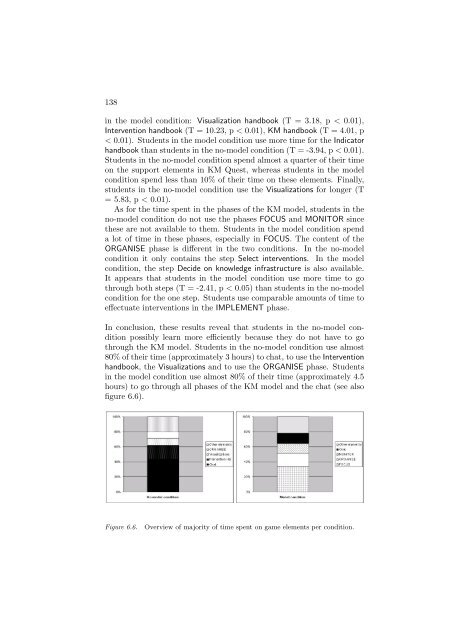The role of metacognitive skills in learning to solve problems
The role of metacognitive skills in learning to solve problems
The role of metacognitive skills in learning to solve problems
Create successful ePaper yourself
Turn your PDF publications into a flip-book with our unique Google optimized e-Paper software.
138<br />
<strong>in</strong> the model condition: Visualization handbook (T = 3.18, p < 0.01),<br />
Intervention handbook (T = 10.23, p < 0.01), KM handbook (T = 4.01, p<br />
< 0.01). Students <strong>in</strong> the model condition use more time for the Indica<strong>to</strong>r<br />
handbook than students <strong>in</strong> the no-model condition (T = -3.94, p < 0.01).<br />
Students <strong>in</strong> the no-model condition spend almost a quarter <strong>of</strong> their time<br />
on the support elements <strong>in</strong> KM Quest, whereas students <strong>in</strong> the model<br />
condition spend less than 10% <strong>of</strong> their time on these elements. F<strong>in</strong>ally,<br />
students <strong>in</strong> the no-model condition use the Visualizations for longer (T<br />
= 5.83, p < 0.01).<br />
As for the time spent <strong>in</strong> the phases <strong>of</strong> the KM model, students <strong>in</strong> the<br />
no-model condition do not use the phases FOCUS and MONITOR s<strong>in</strong>ce<br />
these are not available <strong>to</strong> them. Students <strong>in</strong> the model condition spend<br />
a lot <strong>of</strong> time <strong>in</strong> these phases, especially <strong>in</strong> FOCUS. <strong>The</strong> content <strong>of</strong> the<br />
ORGANISE phase is different <strong>in</strong> the two conditions. In the no-model<br />
condition it only conta<strong>in</strong>s the step Select <strong>in</strong>terventions. In the model<br />
condition, the step Decide on knowledge <strong>in</strong>frastructure is also available.<br />
It appears that students <strong>in</strong> the model condition use more time <strong>to</strong> go<br />
through both steps (T = -2.41, p < 0.05) than students <strong>in</strong> the no-model<br />
condition for the one step. Students use comparable amounts <strong>of</strong> time <strong>to</strong><br />
effectuate <strong>in</strong>terventions <strong>in</strong> the IMPLEMENT phase.<br />
In conclusion, these results reveal that students <strong>in</strong> the no-model condition<br />
possibly learn more efficiently because they do not have <strong>to</strong> go<br />
through the KM model. Students <strong>in</strong> the no-model condition use almost<br />
80% <strong>of</strong> their time (approximately 3 hours) <strong>to</strong> chat, <strong>to</strong> use the Intervention<br />
handbook, the Visualizations and <strong>to</strong> use the ORGANISE phase. Students<br />
<strong>in</strong> the model condition use almost 80% <strong>of</strong> their time (approximately 4.5<br />
hours) <strong>to</strong> go through all phases <strong>of</strong> the KM model and the chat (see also<br />
figure 6.6).<br />
Figure 6.6.<br />
Overview <strong>of</strong> majority <strong>of</strong> time spent on game elements per condition.
















